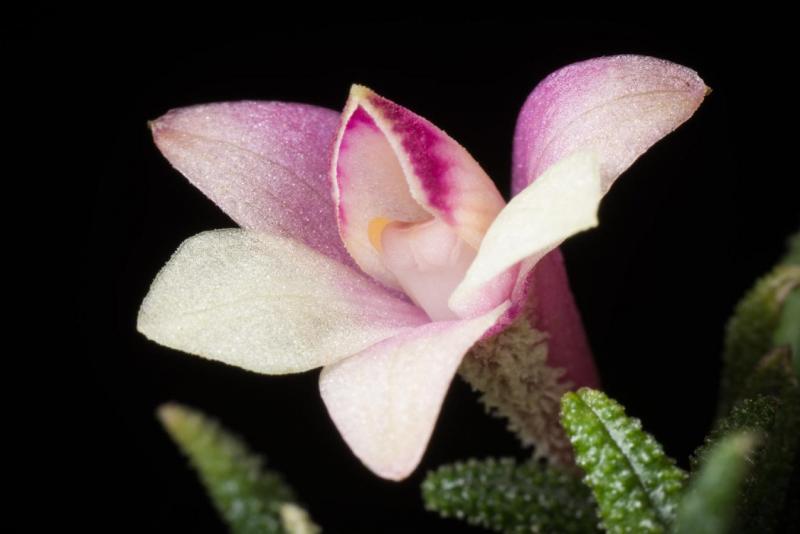Dendrobium cuthbertsonii
Also known as: Cuthbertson's Dendrobium or Pedilonum euphues Pedilonum asperifolium Pedilonum coccinellum Dendrobium cuthbertsonii h.v. agathodaemonis Dendrobium cuthbertsonii h.f. semialba Dendrobium cuthbertsonii h.f. alba Dendrobium cuthbertsonii h.v. bicolor Dendrobium cuthbertsonii h.f. bicolor Dendrobium cuthbertsonii h.f. rubrum Dendrobium cuthbertsonii h.f. roseum Dendrobium asperifolium Dendrobium coccinellum Dendrobium trachyphyllum Dendrobium carstensziense Dendrobium euphues Dendrobium lichenicola Dendrobium atromarginatum Dendrobium laetum Dendrobium agathodaemonis Dendrobium sophronitis Dendrobium sophronites Maccraithea sophronites Maccraithea euphues Maccraithea trachyphylla Maccraithea lichenicola Maccraithea coccinella Maccraithea atromarginata Maccraithea asperifolia Maccraithea agathodaemonis Pedilonum trachyphyllum Pedilonum sophronites in the subfamily: Epidendroideae
General Information
Cuthbertson's Dendrobium is a miniature sympodial cold to warm growing epiphytic, lithophytic or terrestrial orchid belonging to the sub family Epidendroideae. It is named after the English Collector in Asia in the 19th century.
Plant Description
Sympodial. Grows to 2-8cm. Each new growth has numerous elliptic leaves that grow to 0.5-4.2cm long. Pseudobulbs grow to 0.5-13cm
Substrate(s)
- Spaghnum Moss
Care Notes
These orchids live in environments that receive constant moisture, high humidity, and are surrounded by other plants such as ferns and mosses which not only attract moisture but compete for it as well.
As a consequence they can be difficult to keep healthy in an artificial environment where a constant balance has to be maintained between providing constant moisture to the roots, but also allowing them to not become soggy and dry quickly as they would in the wild. For this reason it's important to take into account the size of the plant, the health and fragility of the root system, and also think about your watering habits. If you water frequently you can use a media that drains more freely, if you water less reliably you will need to find a media that offers retention and keeps humidity around the roots without being soggy.
Because these orchids like high amounts of water, other plants such as ferns and weeds may start to grow alongside the orchid, whose roots can make the media quite dense, effectively strangling the orchid's roots, it's best to pluck them out before they become a problem. Fungus and bacteria can be an issue as well, but usually are a sign of overwatering, smell the media occasionally to check, and increase airflow, reduce watering, and adjust temperatures accordingly (often bacteria only flourish in warmer temperatures, fungus less so).
Climate
These orchids thrive in hot, steamy locations, living in low altitude jungle areas where they often receive heavy sporadic rainfall, warm humid winds, and sunlight filtered year round by the surrounding growth.
They can survive, but will often struggle if the humid, warm conditions are not met - roots will die back and leaves will thin out, spikes and buds can be aborted if conditions change too frequently during flowering. They can tolerate cooler or drier conditions temporarily, but extended exposure will seriously affect them.
They will grow best in the tropics, especially coastal areas where they receive ocean breezes, but can do well in a greenhouse, supplied that the humidity is kept high, temperature is not allowed to skyrocket and extra shade is provided during hot weather.
Grows at low to high elevations. Rainfall ranges from 102mm to 244mm per day, heaviest in August and lightest in January. Temperature ranges from 10C to 26C, highest in July (12C to 26C) and lowest in February (10C to 22C).
Watering
These orchids prefer a constant supply of moisture, with a slight drying out between waterings. Saucers can be placed under pots to retain moisture during hot weather, however the saucers should be removed or let to dry every 1-2 weeks to prevent rot. Keep an eye on the plant especially in hot weather and look for cues of under/overwatering and adjust accordingly.
Be sure to provide strong air circulation after watering to prevent fungal and bacterial infections from water sitting on leaves.Fertiliser
Apply liquid based fertiliser per recommended directions. They can benefit from a high phosphate fertiliser leading up to flowering season, followed by a high nitrogen fertiliser when new growth appears, and a balanced fertiliser in other times. These orchids can also tolerate slow release fertiliser applied 1-2 pellets per cup (250ml) of media.
Use balanced fertiliser year round. Apply fertiliser regularly at half strength year round.Potting
These plants can be sensitive to repotting though should not require repotting regularly. Repotting should be done when the mix has broken down to the point that it doesn't absorb water or holds onto water for far too long, usually the plant shows a decline in growth as well.
The mix should be free draining, with a blend of 30% inorganic ingredients such as coarse sand, gravel or perlite, mixed in with about 70% organic ingredients such as peat, leaf litter or decomposed bark. Avoid commercial potting mixes as they can vary wildly and may contain "wetting agents" that can hold onto water for loo long, causing rotting and stunted growth.
Repotting is best done annually.




















